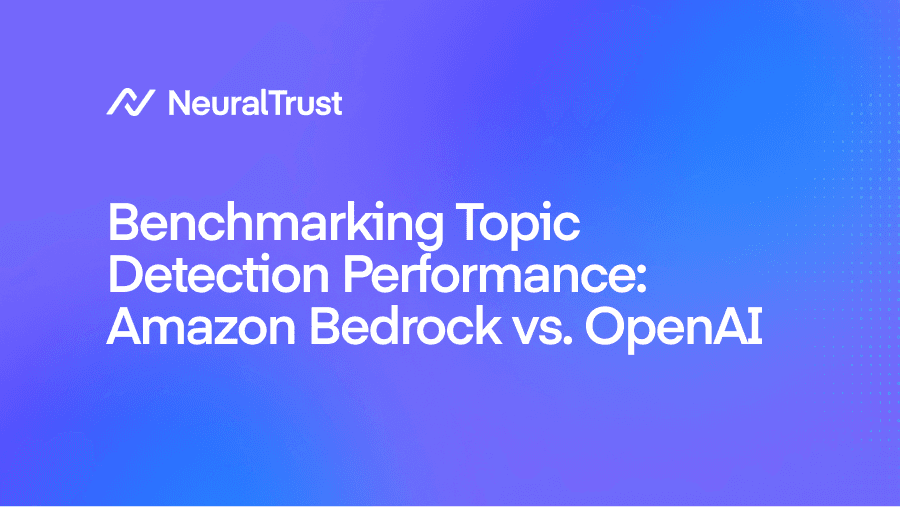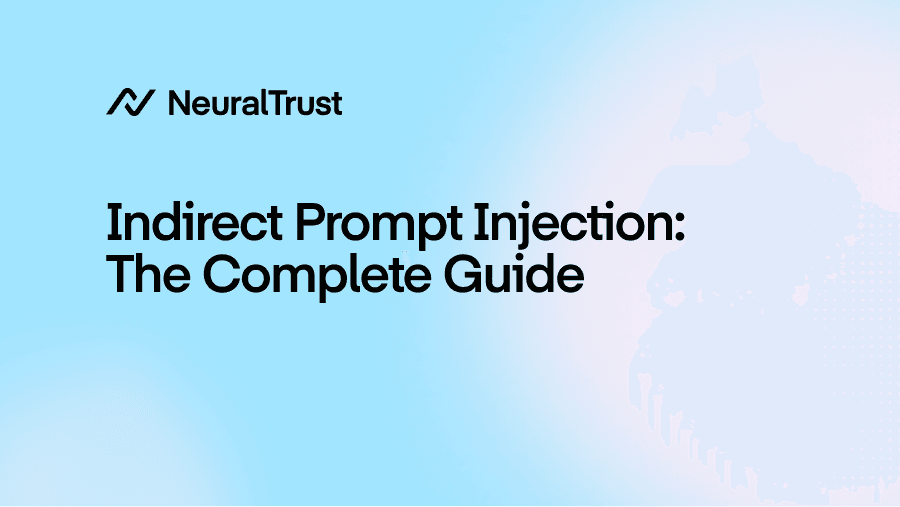Topic detection is a fundamental capability in natural language processing with applications spanning content management, recommendation systems, search functionality, and more. As organizations process increasing volumes of text data, the ability to accurately and efficiently categorize content becomes essential.
In this comparison, we examine two powerful approaches to implementing topic detection:
1. Amazon Bedrock Guardrail: A configurable AWS service designed for efficient topic detection. See full guide here.
2. OpenAI's GPT-4 Mini: A state-of-the-art language model with impressive classification capabilities. See full guide here.
Both approaches were tested on the same dataset comprising 2,926 text samples across 14 diverse topic categories, providing a fair and comprehensive evaluation of their performance characteristics.
The Dataset
Our benchmark utilized a balanced dataset with the following topic distribution:
- Health & Medicine (235 samples)
- Education (216 samples)
- Technology (209 samples)
- Politics (207 samples)
- Food & Cooking (207 samples)
- Psychology & Self-Development (206 samples)
- Environment & Climate (206 samples)
- Entertainment (204 samples)
- Business & Entrepreneurship (204 samples)
- Travel & Tourism (203 samples)
- Science & Space (202 samples)
- Sports (201 samples)
- History (200 samples)
- Finance & Economy (185 samples)
Sample texts ranged from simple statements like "The latest iPhone model features an A17 Bionic chip" (Technology) to more nuanced content across all categories.
Performance Metrics
Our benchmark evaluated both approaches based on two critical metrics:
- Accuracy: The percentage of correctly classified topics
- Processing Speed: Average time to process each text sample
| Metric | Amazon Bedrock Guardrail | OpenAI GPT-4 Mini |
|---|---|---|
| Accuracy | 58% | 88.1% |
| Processing Time | 0.357 seconds | 0.650 seconds |
| Throughput Capability | ~10,000 samples/hour | ~5,500 samples/hour |
Amazon Bedrock Guardrail: Performance Analysis
The accuracy is directly influenced by the contextual grounding threshold setting. Our testing revealed that with the default threshold value of 0.7, Bedrock Guardrail achieves an approximate accuracy of 58% with a moderate false positive rate. This configuration processes text samples in an average of 0.357 seconds, striking a reasonable balance between accuracy and speed.
Speed and Efficiency
Bedrock Guardrail demonstrated impressive processing efficiency:
- Average Processing Time: 0.357 seconds per text sample
- Throughput Capability: Can process approximately 10,000 text samples in about 1 hour
- Consistent Performance: Minimal variance in processing time across different topic categories and text lengths
Resource Utilization
Bedrock Guardrail is designed to be efficient with computational resources:
- Memory Usage: Minimal compared to running large language models locally
- Scaling: Handles increased load gracefully through AWS's infrastructure
- Cost Efficiency: Pay-as-you-go pricing model based on API calls
OpenAI GPT-4 Mini: Performance Analysis
Accuracy Characteristics
OpenAI's GPT-4 Mini achieved an impressive 88.1% accuracy in topic classification, correctly identifying topics in nearly 9 out of 10 text samples. This represents a 30.1 percentage point improvement over Bedrock Guardrail.
The high accuracy can be attributed to several factors:
- Advanced Language Understanding: GPT-4 Mini's sophisticated language model captures nuanced relationships between topics and content
- Precise Prompt Engineering: The implementation used carefully crafted prompts that clearly defined the classification task
- Structured Output Format: Enforcing JSON output format ensured consistent and parseable results
Speed and Efficiency
While not as fast as Bedrock Guardrail, OpenAI's solution still offered reasonable processing speed:
- Average Processing Time: 0.650 seconds per text sample
- Throughput Capability: Can process approximately 5,500 text samples per hour
- Consistent Results: Reliable classification across diverse topic categories
Implementation Approach
The OpenAI implementation leveraged several key techniques:
- System Prompt Engineering: Establishing the model as an "expert on topic classification" and providing clear instructions
- Structured JSON Output: Requesting a specific output format for consistent parsing
- Role-Based Messaging: Using distinct roles for system instructions and user content
Key Differences and Trade-offs
The comparison reveals a clear trade-off between the two approaches:
Amazon Bedrock Guardrail Advantages:
- Speed: Nearly twice as fast as OpenAI's solution (0.357s vs. 0.650s)
- Configurability: Threshold settings allow fine-tuning for specific use cases
- AWS Integration: Seamless integration with other AWS services
- Resource Efficiency: Designed for efficient scaling with AWS infrastructure
OpenAI GPT-4 Mini Advantages:
- Accuracy: Significantly higher classification accuracy (88.1% vs. 58%)
- Implementation Simplicity: Less configuration required to achieve good results
- Adaptability: Works well across diverse topic categories without extensive tuning
- Minimal Setup: No need to define topic definitions and examples upfront
Use Case Recommendations
Based on the performance characteristics, here are recommendations for when to use each approach:
Consider Amazon Bedrock Guardrail for:
- Applications requiring rapid processing of large text volumes
- Use cases where processing latency is critical
- Scenarios where moderate accuracy is acceptable
- Systems with limited computational resources
- Applications where cost efficiency is a primary concern
- Organizations already leveraging the AWS ecosystem
Consider OpenAI GPT-4 Mini for:
- Applications requiring high topic classification precision
- Use cases where accuracy outweighs processing speed
- Content moderation or compliance scenarios
- Research applications requiring reliable topic identification
- Systems where user trust depends on accurate categorization
- Projects with limited time for extensive configuration and tuning
Optimization Strategies
To maximize the accuracy and efficiency of topic detection, fine-tuning your approach is essential. Both Amazon Bedrock Guardrail and OpenAI’s GPT-4 Mini offer robust capabilities, but their performance can be significantly improved through optimization techniques. From refining topic definitions and adjusting relevance thresholds to leveraging prompt engineering and batch processing, strategic optimizations ensure better precision, scalability, and cost-effectiveness.
For Amazon Bedrock Guardrail:
1. Refine Topic Definitions: Provide comprehensive definitions that clearly distinguish topics
2. Add Diverse Sample Phrases: Include varied examples for each topic
3. Experiment with Relevance Thresholds: Find the optimal balance between precision and recall
4. Combine with Pre-processing: Implement text normalization or keyword extraction
For OpenAI GPT-4 Mini:
1. Refine Prompt Engineering: Experiment with different prompt formulations
2. Try Different Models: Test various OpenAI models for the optimal accuracy/cost balance
3. Implement Error Handling: Add retry logic and exponential backoff for production use
4. Batch Processing: Group requests to improve throughput
Conclusion
The choice between Amazon Bedrock Guardrail and OpenAI GPT-4 Mini for topic detection ultimately depends on your specific requirements and priorities:
-
If speed and cost efficiency are most important, Amazon Bedrock Guardrail offers a compelling solution with its impressive processing time and AWS integration.
-
If accuracy is the primary concern, OpenAI GPT-4 Mini delivers superior classification performance, correctly identifying topics in nearly 9 out of 10 cases.
Both approaches offer powerful capabilities for implementing topic detection in modern applications, and the right choice will depend on your specific use case, performance requirements, and existing technology stack.
As these technologies continue to evolve, we can expect improvements in both accuracy and processing speed, potentially narrowing the gap between these two approaches and offering even more powerful tools for automated topic detection.



